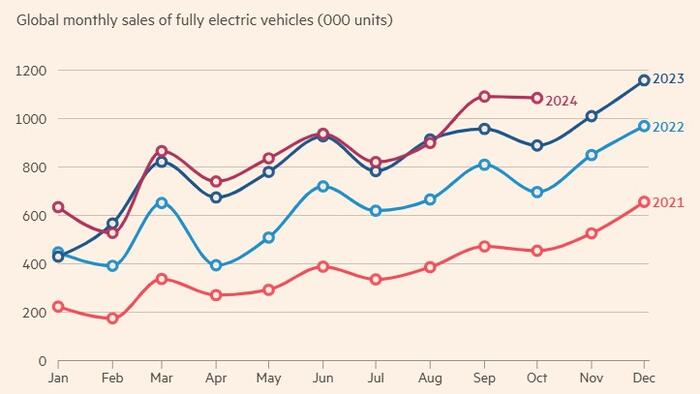The electric vehicle (EV) market, once perceived as a booming sector fueled by government initiatives and consumer enthusiasm, is now facing significant headwinds as competition saturates the market and government support diminishes. A recent Financial Times (FT) report highlights a troubling trend: major shifts in the auto industry towards EVs, which were initially seen as crucial for sustainability, may now be jeopardized by a variety of challenges. For instance, Northvolt, the leading battery producer in Europe, has declared bankruptcy, sparking concerns about the viability of the region’s industrial strategy. Furthermore, Stellantis’s closure of a van plant in the UK threatens over a thousand jobs, indicative of a broader trend that includes job cuts and plant closures by formidable players like Volkswagen and Ford due to a downturn in EV demand. These developments have led to fears that the U.S. is lagging in its green transition, particularly with President-elect Trump’s prospective cuts to EV subsidies, contrasting with President Biden’s goal of achieving a 50% market share for EVs in new car sales by 2030.
Current figures reflect a stark reality: despite ambitious goals, EVs accounted for only 10% of new car sales last year in the U.S. This pessimism is echoed in production plans, as automakers have scaled back their output expectations. Predictions suggest a staggering 50% decrease in U.S. EV production and a 29% drop in Europe in the coming year. Analysts project that by 2025, EV market share may only climb to 23% in Europe and 13% in the U.S., a growth trajectory that seems increasingly uncertain. The slow adoption of EVs can be attributed to several formidable barriers, including high initial costs, consumer apprehensions regarding range and charging infrastructure, as well as diminishing economic advantages in energy pricing amid geopolitical instability.
The rise in interest rates has exacerbated the situation, leading to increased leasing costs for consumers. In Europe, the financial landscape has shifted dramatically, with median EV prices increasing from €40,000 in 2020 to €45,000 today. This is significantly higher than the estimated €20,000 price point many consumers find acceptable, further complicating the widespread adoption of EVs. Inconsistent government subsidies have also conspired against establishing a stable consumer base, particularly when countries like Germany and France have decreased their incentive programs, raising concerns of declining sales and potential job losses across the auto sector.
In stark contrast, China has effectively integrated its EV strategy, benefiting from substantial state-backed initiatives, generous subsidies, and a resilient supply chain, leading it to dominate the global EV market. Currently, over half of all new cars sold in China are EVs or plug-in hybrids. This success can be attributed to competitive pricing and innovative technological features in vehicles, which resonate well with consumers. Europe faces systemic difficulties in replicating China’s state-driven economic model, leading to strategies like imposing tariffs on imported Chinese EVs in an effort to protect its market. Yet, despite these setbacks, automakers in Europe cling to optimism, navigating the challenges by planning for affordable EV models priced below €25,000. This could help them align with stricter emissions targets while meeting consumer interests in more economical electric vehicles.
Analysts have expressed concern regarding the revisions to production forecasts for the EV industry, suggesting a noticeable downward trend. Daniel Roeska from Bernstein notes that the outlook for EV production by 2025 is disheartening, indicating a sustained decline in production expectations across the board. The complexities surrounding EV adoption underscore a broader dilemma in the automotive industry as it grapples with transitions fueled by new technologies and sustainability mandates. The challenges posed by high costs, insufficient infrastructure, and inconsistent regulatory frameworks create a perfect storm that could hinder the growth of electric vehicles, complicating efforts to achieve a sustainable automotive future.
As the landscape for electric vehicles continues to evolve, the current challenges present both obstacles and potential opportunities for innovation within the sector. Automakers must reconcile soaring production costs with the practical expectations of consumers, while also navigating the complex geopolitical and economic realities that shape the market. Balancing affordability with sustainability may prove pivotal, as companies explore various strategies to reduce costs without sacrificing electric vehicle performance or safety. The interplay of market forces, governmental policies, and consumer behavior will be critical in determining the future trajectory of electric vehicles, as stakeholders seek solutions to foster a more robust and sustainable automotive ecosystem.

